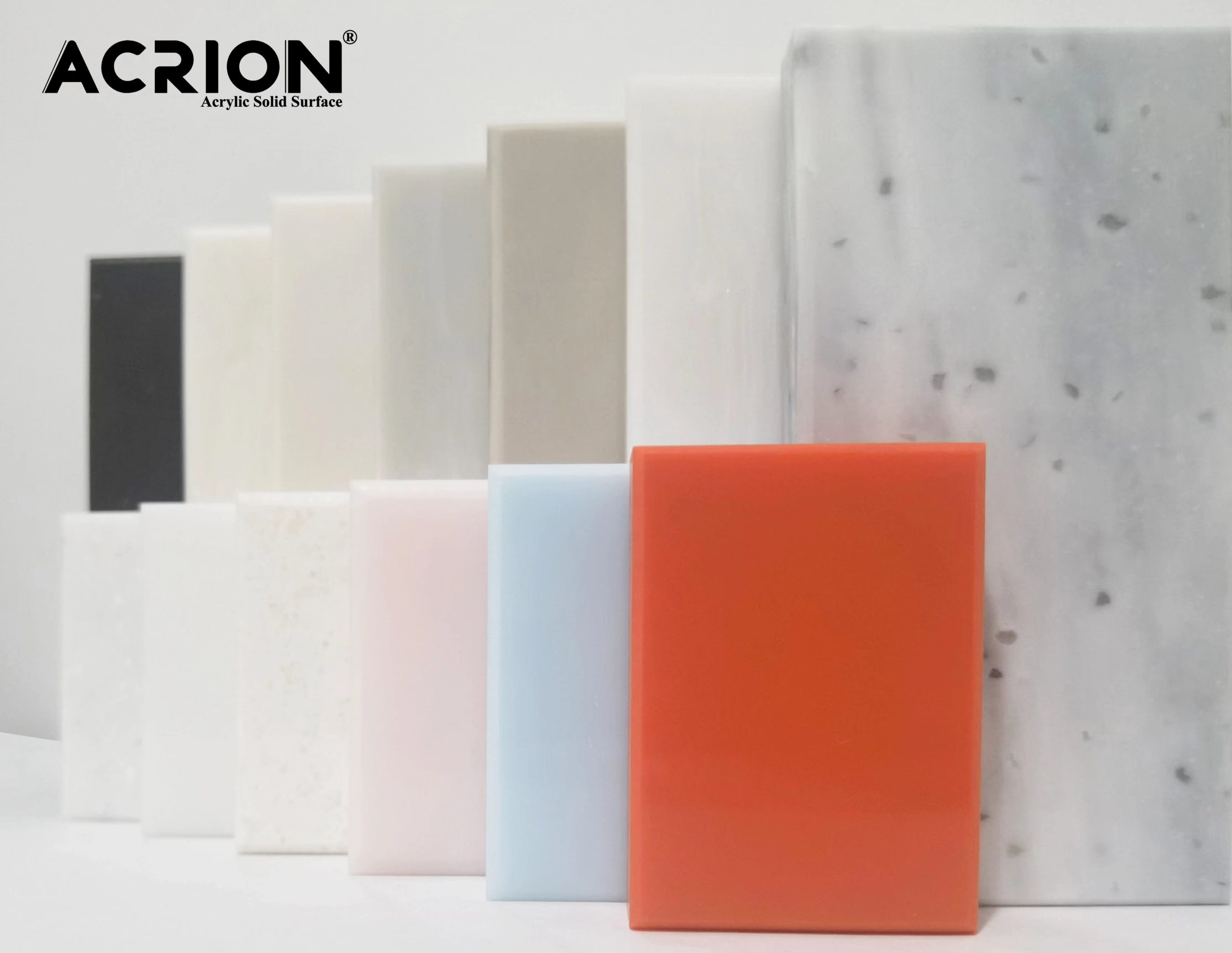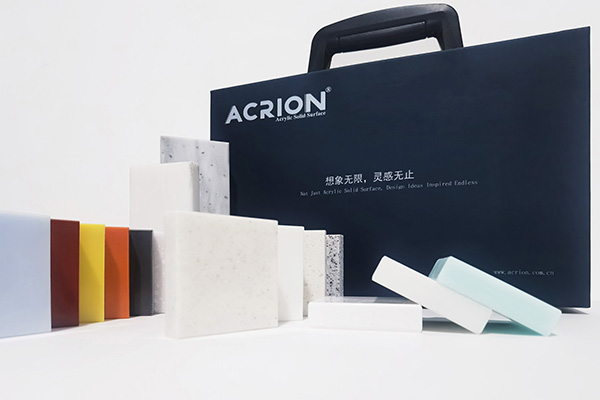A análise do desempenho da resistência à baixa temperatura das superfícies sólidas acrílicas deve ser realizada a partir de três dimensões: estrutura do material, resposta mecânica e interação ambiental, e uma avaliação abrangente deve ser realizada em combinação com testes de laboratório e cenários de aplicação reais. A análise a seguir é realizada a partir de três aspectos: indicadores -chave de desempenho, métodos de teste e mecanismos de falha:
Primeiro, mudanças nas propriedades físicas em ambientes de baixa temperatura
A influência da temperatura de transição vítrea (TG)
O TG da resina acrílica é geralmente entre 0 ℃ e 50 ℃. Quando a temperatura ambiente é menor que o TG, o revestimento muda de um estado altamente elástico para um estado vítreo, e a capacidade de movimento da cadeia molecular diminui significativamente. Por exemplo, um revestimento com um TG de 10 ℃ pode ter sua flexibilidade reduzida em mais de 50% em um ambiente de -10 ℃, resultando em um declínio na resistência ao impacto.
Fenômeno de fragilização de baixa temperatura
A fratura quebradiça pode ocorrer no revestimento dentro da faixa de -30 ℃ a -50 ℃. Pode ser observado através do teste de impacto de entalhe que o revestimento com fratura dúctil à temperatura ambiente se transforma em fratura quebradiça a baixa temperatura, e a seção transversal mostra uma característica do tipo espelhamento, indicando que a energia de propagação da trinca é significativamente reduzida.
Acumulação de estresse de contração
A baixa temperatura faz com que o volume do revestimento diminua. Se o coeficiente de expansão térmica não corresponder ao do substrato, pode desencadear o estresse interfacial. Por exemplo, a diferença de taxa de encolhimento entre o revestimento e o substrato metálico pode atingir 0,5% a -20 ℃, resultando em uma diminuição na adesão ou na rachadura de revestimento.
Segundo, o método de teste para desempenho de baixa temperatura
Teste de temperatura de fragilização de baixa temperatura
De acordo com o padrão GB/T 5470-2008, as amostras de revestimento foram colocadas no equipamento resfriado por nitrogênio líquido e resfriadas a uma taxa de 2 ℃/min. A temperatura na qual o revestimento quebrou foi registrado. A temperatura de fragilização dos revestimentos típicos de acrílico está entre -40 ℃ e -60 ℃. Abaixo desta temperatura, o revestimento é propenso a danos catastróficos.
Teste de flexão de baixa temperatura
Depois de manter a amostra revestida em -20 ℃, -40 ℃ e -60 ℃ por 2 horas, conduza imediatamente um teste de flexão de 180 °. Observe se há rachaduras ou descascamento na superfície do revestimento. Por exemplo, quando o raio de flexão é inferior a 5 mm a -40 ℃, o revestimento pode desenvolver micro -trações no nível de 0,1 mm.
Teste de adesão de baixa temperatura
Depois de ser mantido na temperatura definida por 30 minutos, a adesão foi avaliada pelo método da grade. Por exemplo, um revestimento com o grau 0 de adesão à temperatura ambiente pode cair para o grau 2 em -30 ℃, indicando que a baixa temperatura leva ao enfraquecimento da força de ligação interfacial.
Teste de ciclagem de baixa temperatura
Para simular a diferença de temperatura entre dia e noite, a amostra de revestimento foi submetida a 100 ciclos frios e quentes na faixa de -40 ℃ a 20 ℃, com cada ciclo durando 2 horas. Observe se o revestimento mostra pó, borbulhar ou descascamento e avaliar sua resistência climática a longo prazo.
Terceiro, mecanismos de falha em ambientes de baixa temperatura
Rachaduras causadas pelo estresse interno
O encolhimento de baixa temperatura causa tensão de tração no revestimento. Quando a tensão excede a resistência à tração do revestimento, pode desencadear rachaduras perpendiculares à superfície. Por exemplo, um revestimento com uma espessura de 100μm pode produzir rachaduras radiais de 0,2 mm de largura a -50 ℃.
Interface descasca
Se a adesão entre o revestimento e o substrato for insuficiente, o encolhimento de baixa temperatura pode causar descamação da interface. Pode -se observar por SEM que a seção transversal do revestimento tratada em -30 ℃ mostra uma separação óbvia entre camadas e o resíduo na interface é reduzido.
A separação da microfase se intensifica
Em baixas temperaturas, a compatibilidade entre os segmentos macios e duros na resina acrílica diminui, o que pode levar à separação da microfase. Por exemplo, copolímeros com diferenças significativas na TG podem exibir estruturas de separação de fases no nível de 5 a 10μm a -20 ° C, o que afeta a uniformidade do revestimento.
Quarto, verificação dos cenários de aplicação reais
As paredes externas dos edifícios em regiões extremamente frias
Em um ambiente de -40 ℃, a resistência do revestimento aos ciclos de congelamento e inchaço precisa ser verificada. Por exemplo, mergulhe a amostra revestida em água e congele a -40 ℃, depois transfira para 20 ℃ para fusão. Repita isso 50 vezes e observe se o revestimento descasca.
Equipamento de transporte de cadeia fria
Para ambientes de armazenamento a frio que variam de -25 a -18 ℃, é necessário testar a resistência à corrosão do revestimento sob condições de baixa temperatura e alta umidade. Por exemplo, após o revestimento ser mantido a -20 ℃ e 90%RH por 72 horas, se a geada branca ou a ferrugem aparece na superfície.
Revestimento de equipamentos polares
Sob condições extremamente frias de -60 ℃, a resistência ao impacto do revestimento precisa ser avaliada. Por exemplo, foi adotado um teste de impacto do martelo. O revestimento foi impactado em -60 ℃ com uma energia de 1J e foi registrado se ocorreram rachaduras visíveis.
Quinto, direção de otimização de desempenho
Projeto de estrutura molecular
A introdução de segmentos flexíveis (como acrilato de butil) pode reduzir a TG e melhorar a tenacidade de baixa temperatura. Por exemplo, copolimerizar acrilato de etila com acrilato de butil pode reduzir o TG de 20 ℃ para -10 ℃, melhorando significativamente o desempenho de baixa temperatura.
Regulação da densidade de reticulação
A reticulação moderada pode aumentar a força do revestimento, mas a reticulação excessiva reduzirá sua flexibilidade. Por exemplo, ao ajustar a dosagem do agente de reticulação, a temperatura de fragilização de baixa temperatura pode ser reduzida em 10 ℃, mantendo a dureza.
Modificação de preenchimento
A adição de preenchimentos em nanoescala (como sílica fumada) pode inibir a propagação da trinca. Por exemplo, a adição de 5% de nano -filas pode aumentar o alongamento no intervalo do revestimento em 20% em -40 ℃.



